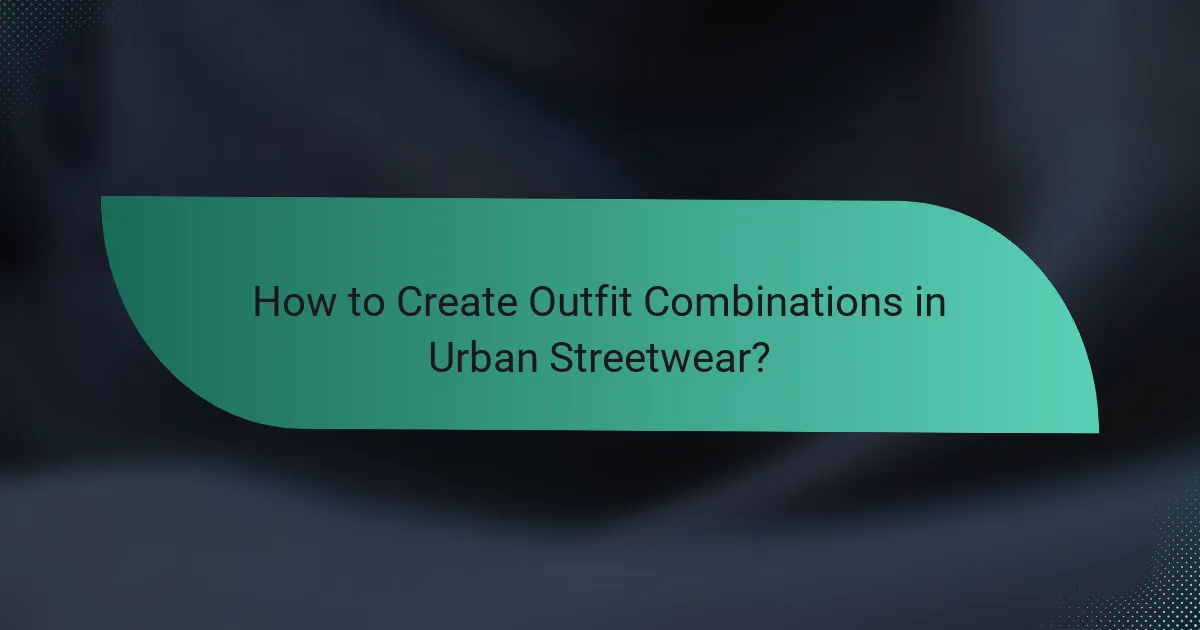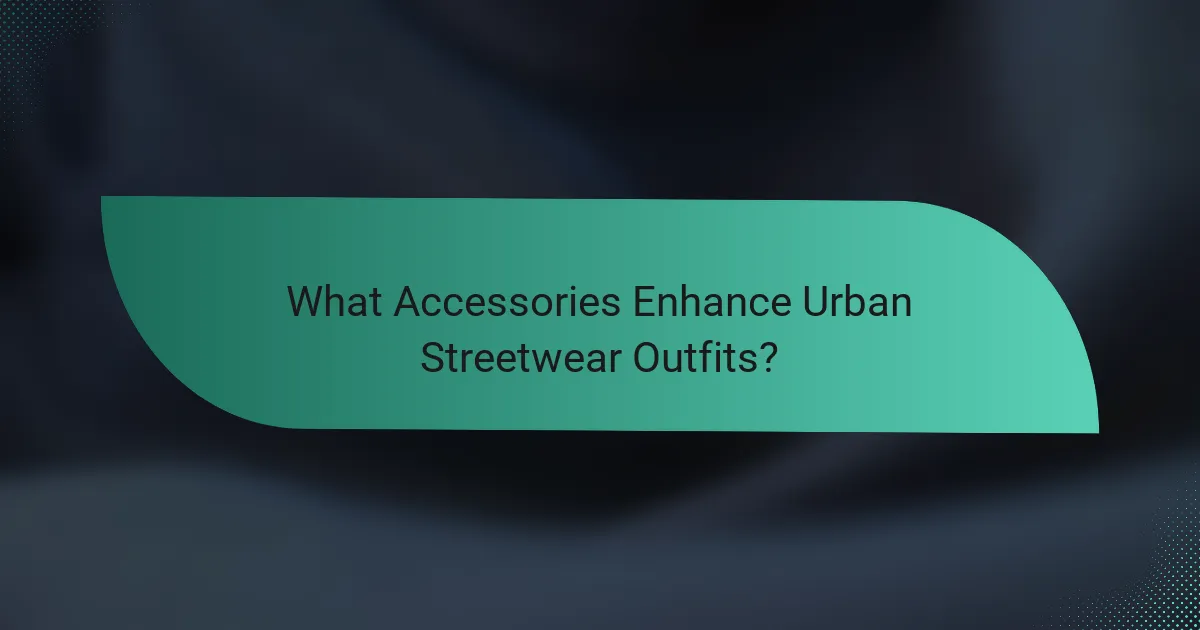
What is Urban Streetwear?
Urban streetwear is a fashion style that emerged from urban culture. It combines elements of hip-hop, skateboarding, and contemporary art. This genre often features casual, comfortable clothing like oversized t-shirts, hoodies, and sneakers. Urban streetwear is known for its bold graphics and unique designs. It reflects social movements and youth culture. The style gained popularity in the 1990s and continues to evolve today. Brands like Supreme and Off-White are notable examples. Urban streetwear represents a lifestyle, not just a clothing choice.
How did Urban Streetwear originate?
Urban streetwear originated in the late 1980s and early 1990s. It emerged from the fusion of hip-hop culture, skateboarding, and punk influences. Key cities like New York and Los Angeles played significant roles in its development. Streetwear brands began to reflect the attitudes and styles of urban youth. Notable brands like Stüssy and Supreme were among the pioneers. They combined casual clothing with bold graphics and logos. This style resonated with the desire for individuality and self-expression. The rise of social media further popularized urban streetwear globally.
What cultural influences shaped Urban Streetwear?
Urban streetwear is shaped by various cultural influences, including hip-hop, skateboarding, and punk music. The hip-hop culture of the 1980s introduced oversized silhouettes and bold graphics. Skateboarding culture contributed to the casual and functional aspects of streetwear. Punk music brought DIY aesthetics and anti-establishment messages. Additionally, urban art movements, particularly graffiti, influenced graphic design in streetwear. Fashion designers also drew inspiration from multicultural backgrounds, blending styles from different ethnic groups. These influences collectively shaped the identity of urban streetwear, making it a dynamic and evolving fashion genre.
How has Urban Streetwear evolved over the years?
Urban streetwear has evolved significantly since its inception in the late 1970s and early 1980s. Initially, it emerged from the hip-hop culture, influenced by music, skate, and graffiti art. In the 1990s, brands like Stüssy and Supreme began to define the aesthetic, focusing on logo-centric designs and limited releases. The 2000s saw a surge in popularity, with collaborations between streetwear and high fashion, exemplified by brands like A Bathing Ape and Off-White.
By the 2010s, urban streetwear became mainstream, with celebrities and influencers adopting the style. Major fashion houses started incorporating streetwear elements into their collections. Today, urban streetwear is characterized by diversity, inclusivity, and sustainability, reflecting broader cultural shifts. The rise of social media has also played a crucial role in its rapid dissemination and evolution.
What are the defining characteristics of Urban Streetwear?
Urban streetwear is characterized by its casual, comfortable, and often oversized clothing. It blends elements of hip-hop culture, skateboarding, and high fashion. Key features include graphic tees, hoodies, and sneakers. Streetwear often incorporates bold colors and unique patterns. It emphasizes individuality and self-expression through personal style. Many streetwear pieces are limited edition, enhancing their exclusivity. The style is heavily influenced by urban environments and youth culture. Collaborations with artists and designers are common in the streetwear scene.
What styles and silhouettes are common in Urban Streetwear?
Common styles in Urban Streetwear include oversized fits, relaxed silhouettes, and layering techniques. Oversized t-shirts and hoodies are signature pieces. Baggy jeans and cargo pants are frequently worn. Streetwear often features graphic prints and bold colors. Athleisure elements like joggers and sneakers are also prevalent. Layering is essential, combining different textures and lengths. Accessories like caps and backpacks complement the outfits. This style reflects a blend of comfort and urban culture.
How does Urban Streetwear differ from other fashion styles?
Urban streetwear differs from other fashion styles through its emphasis on casual, comfortable clothing. It often incorporates elements from hip-hop culture, skateboarding, and youth subcultures. Urban streetwear typically features oversized silhouettes, graphic tees, and hoodies. Unlike high fashion, which focuses on exclusivity, urban streetwear promotes accessibility and inclusivity. Its designs often reflect social and political messages, setting it apart from more traditional fashion styles. Streetwear brands like Supreme and Off-White have gained massive popularity, illustrating this trend’s cultural impact. This style is characterized by its use of bold colors and unique patterns, which are less common in other fashion genres.

How to Create Outfit Combinations in Urban Streetwear?
To create outfit combinations in urban streetwear, start by selecting a statement piece. This could be an oversized graphic tee or a bold jacket. Pair this with complementary bottoms, such as tapered joggers or distressed jeans. Footwear is crucial; opt for trendy sneakers that align with the overall vibe. Accessories like caps or chunky jewelry can enhance the look. Layering is also effective; consider adding a hoodie or flannel shirt. Mixing textures, like denim with cotton or leather, adds depth. Finally, ensure the color palette is cohesive, using neutral tones with pops of color for balance.
What are the essential pieces for Urban Streetwear outfits?
Essential pieces for Urban Streetwear outfits include oversized t-shirts, hoodies, and joggers. These items provide comfort and a relaxed fit, which are key characteristics of streetwear. Sneakers are also crucial, as they complete the urban aesthetic. Accessories like snapback hats and crossbody bags enhance the overall look. Layering is common, often incorporating denim jackets or bomber jackets. Graphic prints and bold logos are popular choices for t-shirts and hoodies. Streetwear outfits often feature a mix of high-end and casual brands, showcasing individual style. This combination of elements defines the urban streetwear culture.
How do you mix and match different clothing items?
To mix and match different clothing items, start by identifying a color palette. Choose colors that complement each other for a cohesive look. Next, combine various textures to add depth to your outfit. For example, pair denim with cotton or leather. Layering is also effective; wear a t-shirt under a jacket for versatility. Accessorizing can enhance the outfit’s overall appeal. Incorporate hats, bags, or jewelry that align with your style. Finally, consider the occasion to ensure your outfit is appropriate. Mixing and matching allows for personal expression and creativity in urban streetwear.
What role do colors and patterns play in outfit combinations?
Colors and patterns significantly influence outfit combinations. They affect visual appeal and personal expression. Colors can evoke emotions and set the mood of an outfit. For example, warm colors often convey energy, while cool colors suggest calmness. Patterns add texture and interest, making outfits more dynamic. Mixing patterns can create a bold statement, but it requires balance to avoid clashing. Fashion guidelines suggest coordinating colors and patterns for a cohesive look. Studies indicate that color combinations can impact perceptions of style and confidence.
How can you layer outfits for a stylish look?
Layering outfits for a stylish look involves combining different clothing pieces to create depth and interest. Start with a base layer, such as a fitted t-shirt or tank top. Add a middle layer, like a button-up shirt or lightweight sweater, for warmth and style. Top it off with an outer layer, such as a jacket or coat, to complete the look.
Choose complementary colors and textures to enhance visual appeal. Accessories like scarves or hats can add further dimension. According to fashion experts, layering not only provides versatility but also allows for easy adaptation to changing weather conditions. This technique is widely used in urban streetwear, where combining styles is key to achieving a unique look.
What layering techniques work best for Urban Streetwear?
Layering techniques that work best for Urban Streetwear include combining oversized outerwear with fitted inner layers. This approach creates a balanced silhouette. Additionally, using hoodies under jackets adds warmth and style. Layering different textures, such as denim with knits, enhances visual interest. Streetwear often incorporates graphic tees as base layers, allowing for personal expression. Accessories like beanies and scarves can also be layered for added depth. These techniques are popular due to their versatility and comfort, aligning with the urban aesthetic.
How do you choose the right outerwear for layering?
Choose outerwear for layering by considering fit, fabric, and functionality. The fit should allow for comfortable movement without being overly bulky. Fabrics like wool, down, or synthetic blends provide warmth without excessive weight. Look for outerwear with features such as zippers and pockets for added practicality. Layering requires versatility, so select pieces that can easily be added or removed. For example, a lightweight jacket can be worn over a hoodie. This approach enhances style while ensuring comfort across varying temperatures.

How to Adapt Urban Streetwear for Different Seasons?
To adapt urban streetwear for different seasons, select appropriate fabrics and layers. In summer, opt for breathable materials like cotton and linen. Incorporate short-sleeve shirts and lightweight shorts. In fall, transition to long-sleeve tops and denim jackets. Layering with hoodies adds warmth. For winter, choose heavier fabrics such as wool and down. Include insulated jackets and thermal layers. In spring, mix lighter outerwear with versatile pieces. Accessories like hats and scarves can enhance style across seasons.
What are the key considerations for seasonal adaptations?
Key considerations for seasonal adaptations include climate, fabric choice, and layering techniques. Climate affects the types of materials suitable for different weather conditions. For example, lightweight fabrics like cotton are ideal for summer, while heavier materials like wool are better for winter. Fabric choice impacts comfort and style; breathable materials are preferred in hot weather. Layering techniques allow versatility in styling, enabling adjustments to temperature changes throughout the day. Accessories, such as hats and scarves, can enhance seasonal adaptations. Overall, these considerations ensure that urban streetwear remains functional and stylish across seasons.
How do you select fabrics suitable for different weather conditions?
To select fabrics suitable for different weather conditions, consider the climate and temperature. For hot weather, lightweight and breathable fabrics like cotton or linen are ideal. These materials allow air circulation and wick moisture away from the skin. In cooler conditions, opt for heavier fabrics such as wool or fleece for insulation. These fabrics retain body heat and provide warmth. For rainy weather, waterproof materials like nylon or polyester are essential. These fabrics repel water and keep the wearer dry. Additionally, consider the fabric’s ability to dry quickly if exposed to moisture. This ensures comfort in varying conditions.
What seasonal trends should you be aware of in Urban Streetwear?
Urban streetwear trends vary with the seasons. In spring, lighter fabrics and vibrant colors become popular. Layering is essential for fluctuating temperatures. Summer trends focus on breathable materials and bold graphics. Oversized fits and shorts are common during this season. Fall introduces warmer tones and heavier fabrics. Layering with jackets and hoodies is prevalent. Winter trends emphasize functionality with insulated outerwear and accessories like beanies. Seasonal collaborations with brands often influence these trends.
How can you transition outfits from summer to winter?
Layering is essential to transition outfits from summer to winter. Start with lightweight summer pieces as a base. Add long-sleeve shirts or turtlenecks underneath summer dresses or short-sleeve tops. Incorporate warmer fabrics like wool or fleece for added insulation. Use jackets or oversized coats for outer layers. Footwear can shift from sandals to ankle boots or sneakers with thicker soles. Accessories like scarves and hats provide warmth and style. Transitioning colors to deeper shades can also reflect the winter season. These methods ensure comfort and style during seasonal changes.
What are some tips for maintaining style while staying warm?
Layering is essential for maintaining style while staying warm. Start with a fitted base layer to retain heat. Add a stylish mid-layer, such as a sweater or hoodie, for comfort. Choose an outer layer like a chic coat or jacket for protection against the elements. Incorporate accessories like scarves and beanies to enhance your outfit. Opt for materials like wool and fleece for warmth without bulk. Footwear should be both stylish and insulated, like trendy boots. Mixing textures can elevate your look while providing necessary warmth. This approach balances fashion with functionality, ensuring you stay stylish in colder weather.
How do accessories play a role in seasonal transitions?
Accessories significantly influence seasonal transitions by enhancing functionality and style. In colder months, accessories like scarves, hats, and gloves provide warmth and protection. They also serve as fashion statements, allowing individuals to express personal style. During warmer seasons, accessories such as sunglasses and lightweight bags offer practicality and comfort. They help complete outfits while adapting to changing weather. Accessories can also introduce seasonal colors and patterns, refreshing a wardrobe. For instance, floral prints may emerge in spring, while earthy tones dominate fall. This versatility makes accessories essential for navigating seasonal changes effectively.

What Accessories Enhance Urban Streetwear Outfits?
Hats, chains, bags, and sunglasses enhance urban streetwear outfits. Hats like beanies or snapbacks add a casual vibe. Chains provide a bold statement, often in gold or silver. Bags, such as crossbody or fanny packs, offer practicality and style. Sunglasses, particularly oversized or colored lenses, complete the look. Each accessory contributes to the overall aesthetic of urban streetwear.
What types of accessories are popular in Urban Streetwear?
Popular accessories in Urban Streetwear include snapback hats, bucket hats, and beanies. These headwear options are widely recognized for their casual style. Additionally, backpacks and crossbody bags are essential for practicality and fashion. They often feature bold designs and logos. Jewelry such as chunky chains and hoop earrings adds a distinctive flair. Footwear choices like high-top sneakers are also integral to the look. Accessories like sunglasses and statement belts complete the ensemble. These items reflect the culture’s emphasis on individuality and self-expression.
How do hats, bags, and jewelry complement outfits?
Hats, bags, and jewelry enhance outfits by adding style, functionality, and personal expression. Hats provide sun protection and can define a look. They come in various styles, such as beanies or fedoras, each influencing the outfit’s vibe. Bags serve a practical purpose by carrying essentials while contributing to the overall aesthetic. Different bag styles, like backpacks or crossbody bags, can shift an outfit’s tone. Jewelry adds a finishing touch, with pieces like necklaces or bracelets drawing attention. Accessories can transform a basic look into a statement outfit. According to fashion experts, well-chosen accessories can elevate an outfit by reflecting individual taste and creativity.
What are some unique accessories that can elevate a look?
Unique accessories that can elevate a look include statement belts, bold hats, and layered necklaces. Statement belts can transform a simple outfit into a fashion statement. Bold hats, such as fedoras or beanies, add personality and flair. Layered necklaces create depth and interest around the neckline. Other unique accessories are oversized sunglasses and colorful bags, which can serve as focal points. Each of these accessories can enhance an outfit’s overall aesthetic. They provide opportunities for self-expression and individuality in urban streetwear.
How can you choose the right accessories for your outfit?
To choose the right accessories for your outfit, consider color coordination and style consistency. Accessories should complement the main colors of your outfit. For example, if wearing a neutral outfit, colorful accessories can add interest. Additionally, match the style of your accessories to the overall vibe of your outfit. A casual outfit pairs well with relaxed accessories, while a formal look requires more refined pieces. Balance is key; avoid overcrowding your look with too many accessories. Instead, focus on one statement piece, such as a bold necklace or a unique bag. Finally, consider the occasion; accessories should be appropriate for the setting. For instance, a casual day out allows for playful accessories, while a business meeting calls for more understated choices.
What factors should you consider when selecting accessories?
When selecting accessories, consider functionality, style, and versatility. Functionality ensures the accessory serves a practical purpose, like a bag for carrying essentials. Style should align with your overall outfit aesthetic, enhancing your urban streetwear look. Versatility allows the accessory to complement multiple outfits, maximizing its use. Additionally, consider the material for durability and comfort. Color coordination with your outfit is also crucial for a cohesive appearance. Lastly, personal taste should guide your choices to reflect your individuality.
How do you balance accessories with the overall outfit style?
To balance accessories with overall outfit style, prioritize harmony between pieces. Choose accessories that complement the outfit’s color scheme. For example, if wearing neutral tones, select accessories in similar shades or textures. Consider the outfit’s silhouette; oversized outfits may require smaller accessories to avoid overwhelming the look. Conversely, a fitted outfit can handle larger statement pieces. Balance is also achieved through proportion; if the outfit is busy, opt for simpler accessories. According to fashion experts, this approach enhances visual appeal without clashing.
What are some practical tips for styling Urban Streetwear effectively?
Wear oversized clothing for a relaxed, urban vibe. Oversized shirts and hoodies are popular in streetwear. Pair them with fitted bottoms like skinny jeans or joggers. This contrast enhances the overall look. Incorporate graphic tees for a bold statement. They often showcase unique designs or logos. Layer with a denim or bomber jacket for added style. Choose sneakers that complement your outfit. High-tops or chunky styles are trendy in urban fashion. Accessorize with caps or beanies to complete the look. These items add personality and flair. Lastly, mix and match textures for depth. Combining materials like cotton, denim, and leather creates visual interest.
Urban streetwear is a fashion style that integrates elements from hip-hop, skateboarding, and contemporary art, characterized by casual and comfortable clothing such as oversized t-shirts, hoodies, and sneakers. This article provides a comprehensive overview of how to style urban streetwear, including outfit combinations, seasonal adaptations, and essential accessories. Key topics include the origins and cultural influences of urban streetwear, defining characteristics, layering techniques, and tips for selecting the right accessories. Additionally, it addresses how to adapt outfits for different seasons while maintaining style and functionality.